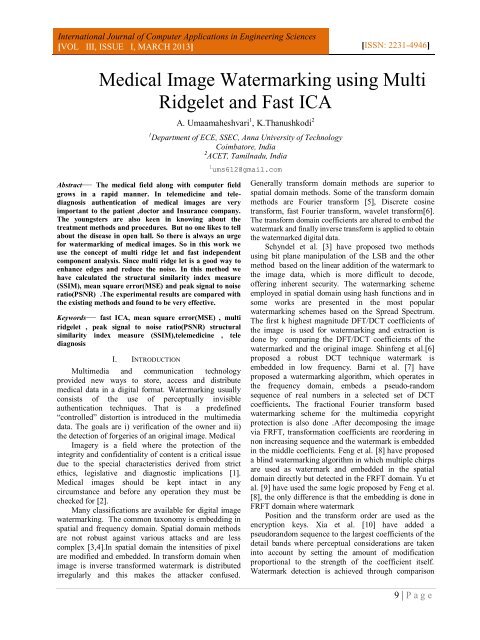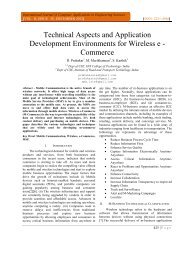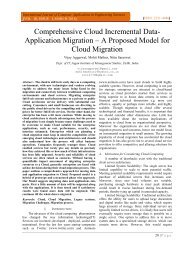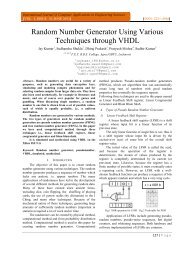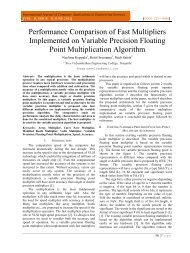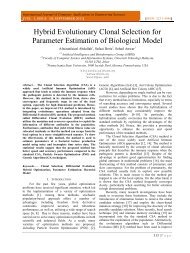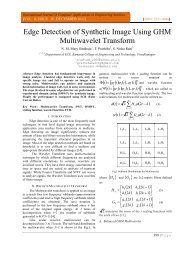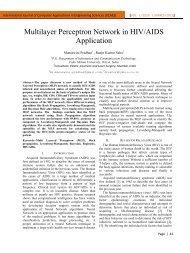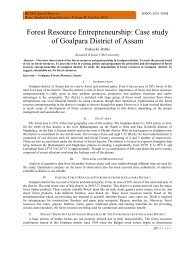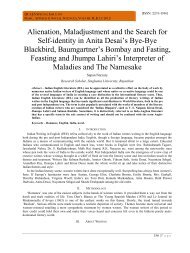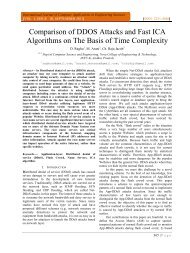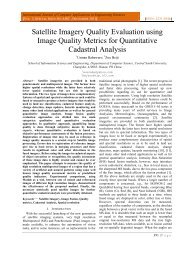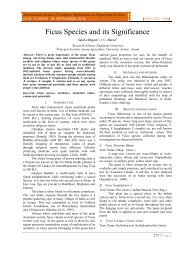IEEE Paper Template in A4 (V1) - International Journal of Computer ...
IEEE Paper Template in A4 (V1) - International Journal of Computer ...
IEEE Paper Template in A4 (V1) - International Journal of Computer ...
You also want an ePaper? Increase the reach of your titles
YUMPU automatically turns print PDFs into web optimized ePapers that Google loves.
<strong>International</strong> <strong>Journal</strong> <strong>of</strong> <strong>Computer</strong> Applications <strong>in</strong> Eng<strong>in</strong>eer<strong>in</strong>g Sciences[VOL III, ISSUE I, MARCH 2013] [ISSN: 2231-4946]Medical Image Watermark<strong>in</strong>g us<strong>in</strong>g MultiRidgelet and Fast ICAA. Umaamaheshvari 1 , K.Thanushkodi 21 Department <strong>of</strong> ECE, SSEC, Anna University <strong>of</strong> TechnologyCoimbatore, India2 ACET, Tamilnadu, India1 ums612@gmail.comAbstract— The medical field along with computer fieldgrows <strong>in</strong> a rapid manner. In telemedic<strong>in</strong>e and telediagnosisauthentication <strong>of</strong> medical images are veryimportant to the patient ,doctor and Insurance company.The youngsters are also keen <strong>in</strong> know<strong>in</strong>g about thetreatment methods and procedures. But no one likes to tellabout the disease <strong>in</strong> open hall. So there is always an urgefor watermark<strong>in</strong>g <strong>of</strong> medical images. So <strong>in</strong> this work weuse the concept <strong>of</strong> multi ridge let and fast <strong>in</strong>dependentcomponent analysis. S<strong>in</strong>ce multi ridge let is a good way toenhance edges and reduce the noise. In this method wehave calculated the structural similarity <strong>in</strong>dex measure(SSIM), mean square error(MSE) and peak signal to noiseratio(PSNR) .The experimental results are compared withthe exist<strong>in</strong>g methods and found to be very effective.Keywords— fast ICA, mean square error(MSE) , multiridgelet , peak signal to noise ratio(PSNR) structuralsimilarity <strong>in</strong>dex measure (SSIM),telemedic<strong>in</strong>e , telediagnosisI. INTRODUCTIONMultimedia and communication technologyprovided new ways to store, access and distributemedical data <strong>in</strong> a digital format. Watermark<strong>in</strong>g usuallyconsists <strong>of</strong> the use <strong>of</strong> perceptually <strong>in</strong>visibleauthentication techniques. That is a predef<strong>in</strong>ed―controlled‖ distortion is <strong>in</strong>troduced <strong>in</strong> the multimediadata. The goals are i) verification <strong>of</strong> the owner and ii)the detection <strong>of</strong> forgeries <strong>of</strong> an orig<strong>in</strong>al image. MedicalImagery is a field where the protection <strong>of</strong> the<strong>in</strong>tegrity and confidentiality <strong>of</strong> content is a critical issuedue to the special characteristics derived from strictethics, legislative and diagnostic implications [1].Medical images should be kept <strong>in</strong>tact <strong>in</strong> anycircumstance and before any operation they must bechecked for [2].Many classifications are available for digital imagewatermark<strong>in</strong>g. The common taxonomy is embedd<strong>in</strong>g <strong>in</strong>spatial and frequency doma<strong>in</strong>. Spatial doma<strong>in</strong> methodsare not robust aga<strong>in</strong>st various attacks and are lesscomplex [3,4].In spatial doma<strong>in</strong> the <strong>in</strong>tensities <strong>of</strong> pixelare modified and embedded. In transform doma<strong>in</strong> whenimage is <strong>in</strong>verse transformed watermark is distributedirregularly and this makes the attacker confused.Generally transform doma<strong>in</strong> methods are superior tospatial doma<strong>in</strong> methods. Some <strong>of</strong> the transform doma<strong>in</strong>methods are Fourier transform [5], Discrete cos<strong>in</strong>etransform, fast Fourier transform, wavelet transform[6].The transform doma<strong>in</strong> coefficients are altered to embed thewatermark and f<strong>in</strong>ally <strong>in</strong>verse transform is applied to obta<strong>in</strong>the watermarked digital data.Schyndel et al. [3] have proposed two methodsus<strong>in</strong>g bit plane manipulation <strong>of</strong> the LSB and the othermethod based on the l<strong>in</strong>ear addition <strong>of</strong> the watermark tothe image data, which is more difficult to decode,<strong>of</strong>fer<strong>in</strong>g <strong>in</strong>herent security. The watermark<strong>in</strong>g schemeemployed <strong>in</strong> spatial doma<strong>in</strong> us<strong>in</strong>g hash functions and <strong>in</strong>some works are presented <strong>in</strong> the most popularwatermark<strong>in</strong>g schemes based on the Spread Spectrum.The first k highest magnitude DFT/DCT coefficients <strong>of</strong>the image is used for watermark<strong>in</strong>g and extraction isdone by compar<strong>in</strong>g the DFT/DCT coefficients <strong>of</strong> thewatermarked and the orig<strong>in</strong>al image. Sh<strong>in</strong>feng et al.[6]proposed a robust DCT technique watermark isembedded <strong>in</strong> low frequency. Barni et al. [7] haveproposed a watermark<strong>in</strong>g algorithm, which operates <strong>in</strong>the frequency doma<strong>in</strong>, embeds a pseudo-randomsequence <strong>of</strong> real numbers <strong>in</strong> a selected set <strong>of</strong> DCTcoefficients. The fractional Fourier transform basedwatermark<strong>in</strong>g scheme for the multimedia copyrightprotection is also done .After decompos<strong>in</strong>g the imagevia FRFT, transformation coefficients are reorder<strong>in</strong>g <strong>in</strong>non <strong>in</strong>creas<strong>in</strong>g sequence and the watermark is embedded<strong>in</strong> the middle coefficients. Feng et al. [8] have proposeda bl<strong>in</strong>d watermark<strong>in</strong>g algorithm <strong>in</strong> which multiple chirpsare used as watermark and embedded <strong>in</strong> the spatialdoma<strong>in</strong> directly but detected <strong>in</strong> the FRFT doma<strong>in</strong>. Yu etal. [9] have used the same logic proposed by Feng et al.[8], the only difference is that the embedd<strong>in</strong>g is done <strong>in</strong>FRFT doma<strong>in</strong> where watermarkPosition and the transform order are used as theencryption keys. Xia et al. [10] have added apseudorandom sequence to the largest coefficients <strong>of</strong> thedetail bands where perceptual considerations are taken<strong>in</strong>to account by sett<strong>in</strong>g the amount <strong>of</strong> modificationproportional to the strength <strong>of</strong> the coefficient itself.Watermark detection is achieved through comparison9 | P a g e
Umaamaheshvari et. al.with the orig<strong>in</strong>al un-watermarked image. Barni et al.[11] proposed a method based on the characteristics <strong>of</strong>the human visual system operat<strong>in</strong>g <strong>in</strong> wavelet doma<strong>in</strong>.Based on the texture and the lum<strong>in</strong>ance content <strong>of</strong> allimage sub-bands, a mask is accomplished pixel by pixel.Kundur et al. [12] proposed the use <strong>of</strong> gray scale logo aswatermark. They addressed a multi resolution fusionbased watermark<strong>in</strong>g method for embedd<strong>in</strong>g gray scalelogos <strong>in</strong>to wavelet transformed images via saliencefactor. Wang et al. [13] and Zhang et al. [14] proposed anew watermark<strong>in</strong>g algorithm based on wavelet treequantization. The detailed survey on wavelet basedwatermark<strong>in</strong>g techniques can be found <strong>in</strong> [15].A multi ridge let transform along with fast ICA isproposed <strong>in</strong> this paper. The experimental results <strong>of</strong> theproposed method are compared with the alreadyavailable watermark<strong>in</strong>g paper.In the organization <strong>of</strong> the paper the history <strong>of</strong>watermark<strong>in</strong>g methods is given <strong>in</strong> section I , a briefnote on ridge lets is given <strong>in</strong> section II, a brief overview<strong>of</strong> fast <strong>in</strong>dependent component analysis is given <strong>in</strong>section III, Watermark embedd<strong>in</strong>g and extraction isgiven <strong>in</strong> section IV. Results and conclusion are given <strong>in</strong>section V.II.RIDGELET TRANSFORMRidgelet transform deals with l<strong>in</strong>e or super-planes<strong>in</strong>gularities. The general overview is given below.Let Ψ be <strong>in</strong> L2(R) with sufficient decay andsatisfies the admissibility condition,KΨ := ∫ |Ψˆ(ξ)| 2 /|(ξ) 2 dξ ⊂ ∞ ……………..………..(1)That KΨ = 1.For a> 0,b ∈ R and Θ ∈[0,2π].In 2-D, po<strong>in</strong>ts and l<strong>in</strong>es are related via the Radontransform, thus the wavelet and ridgelet transforms arel<strong>in</strong>ked via the Radon transform. More precisely, denotethe Radon transform asRf( Θ ,t)=∫f ( x1,x2, ) δ( x1cos Θ +x2 s<strong>in</strong> Θ −t) dx 1 dx 2 …….(2)then the ridgelet transform is the application <strong>of</strong> a 1-Dwavelet transform to the slices (also referred to asprojections) <strong>of</strong> the Radon transform.CRTf (a, b, Θ)=∫Ψ a,b (t)R f (θ,t)dt………………………….(3)For f ∈ L1 (R2 ) is represented as a cont<strong>in</strong>uoussuperposition <strong>of</strong> Ridgelet coefficient and is given byRf(a,b, Θ)= ∫ f(x)Ψa,b,Θ(x)dx ……………………..(4)Any Function f ∈ L1(R2 ) ∩ L2(R)2 is represented as acont<strong>in</strong>uous superposition <strong>of</strong> Ridgelet functions.F(x) = ∫∫∫Rf(a,b,θ)Ψ a,b, θ(x)da…………………………(5)A. Discrete Ridgelet TransformA cont<strong>in</strong>uous ridgelet transform is calculated byapply<strong>in</strong>g 1D wavelet transform to the slices <strong>of</strong> radontransform R f (θ). In radon transform a famous projectionslicetheorem is used. This theorem says that the Radontransform can be obta<strong>in</strong>ed by apply<strong>in</strong>g the onedimensional<strong>in</strong>verse Fourier transform to the twodimensionalFourier transform <strong>of</strong> function restricted toradial l<strong>in</strong>es through the orig<strong>in</strong>. The relation among theFourier, radon and ridgetet doma<strong>in</strong> is depicted shown <strong>in</strong>Fig. 1.Fig .1 Relations between Doma<strong>in</strong>sTo complete the ridge let transform, apply a onedimensional wavelet transform along the radial variable<strong>in</strong> Radon space. The sum up <strong>of</strong> above procedure isshown <strong>in</strong> Fig. 2 <strong>in</strong> the form <strong>of</strong> flow chart. The DRT <strong>of</strong>an image <strong>of</strong> size n×n is an image <strong>of</strong> size2n×2n,<strong>in</strong>troduc<strong>in</strong>g a redundancy factor equal to 4[25,26].F(ωcosθ,ωs<strong>in</strong>θ) = ∫R f (θ,t)e -2πiωx dt ………………..(6)B. Multiscale Ridgelet TransformMultiscale ridgelets based on the ridgelet transformcomb<strong>in</strong>ed with a spatial bandpass filter<strong>in</strong>g operation toisolate different scales .Algorithm‣ Apply a trous algorithm with M scales‣ Apply Radon Transform on detail sub - bands <strong>of</strong> Mscales.‣ Calculate the ridgelet coefficients by apply<strong>in</strong>g‣ 1D wavelet transform on radon coefficients.‣ Get the multiscale ridgelet coefficient <strong>of</strong> M scales.III.Ridgeletdoma<strong>in</strong>Radon Doma<strong>in</strong>FAST INDEPENDENT COMPONENT ANALYSISIndependent component analysis is a method <strong>of</strong>signal process<strong>in</strong>g and used for data analysis. It is basedon bl<strong>in</strong>d source separation (BSS) method. Without thesource signals the coefficients are used for the recovery<strong>of</strong> the signal.ICA was <strong>in</strong>troduced by Comon, Pierre [16].Hyvar<strong>in</strong>en proposed famous Fast ICA based on negativeentropy pr<strong>in</strong>ciple [17].A. The Mix<strong>in</strong>g Model <strong>of</strong> ICA2D Fourierdoma<strong>in</strong>10 | P a g e
Medical Image Watermark<strong>in</strong>g us<strong>in</strong>g Multi Ridgelet and Fast ICASourcesS 1S 2S NMix<strong>in</strong>gmatrixAFig.3 Watermark Embedd<strong>in</strong>gBDemix<strong>in</strong>gmatrix3.The iterative algorithm f<strong>in</strong>ds the direction <strong>of</strong> weightvector W maximiz<strong>in</strong>g the non-gaussianity <strong>of</strong> theprojection W T X for the data X.4. Randomize the <strong>in</strong>itial weight vector W.5. letFig.2 Mix<strong>in</strong>g Model6. Let7.If not converged go to step 5.imageMultiWat Inversridermegelarkridgelet Fig.4 Watermark emb etExtractiontraeddi ktransfnsfng eormoryWatermark mFAST ICAed image WATERMARKING METHODIV.B. Watermark Embedd<strong>in</strong>gIn the proposed method ,the image and watermarkis decomposed by multiscale ridgelet transform. Thecoefficients <strong>of</strong> mulriscale ridgelet for watermarkimageW MR is embedded <strong>in</strong> the low resolution part <strong>of</strong> theimage I MRI MR (low) = I MR (low) (1+αW MR (low)) .........................(7)From the spectrum analysis <strong>of</strong> the image most <strong>of</strong>the useful <strong>in</strong>formation is located <strong>in</strong> the low resolutionpart <strong>of</strong> the image. The <strong>in</strong>visibility <strong>of</strong> watermark isenhanced by us<strong>in</strong>g proper value for α. On the contrary,<strong>in</strong> case <strong>of</strong> attacks low resolution part <strong>of</strong> the image ispreserved <strong>in</strong> the low representation <strong>of</strong> the image ,mak<strong>in</strong>gthe watermark robust.The other coefficients are embedded <strong>in</strong> the highfrequency components <strong>of</strong> the image represent<strong>in</strong>g theedges and textures. To <strong>in</strong>crease the robustness <strong>of</strong> thewatermark we use the equationI MR (hi)= I MR (hi) + βW MR (hi) .........................................(8)To ma<strong>in</strong>ta<strong>in</strong> the <strong>in</strong>visibility <strong>of</strong> the image.C. Watermark ExtractionFor extraction process Fast ICA is used.1. Before apply<strong>in</strong>g fast ICA the <strong>in</strong>put vector datashould be centered.2. The data should be centered by comput<strong>in</strong>g themean <strong>of</strong> each component <strong>of</strong> X and subtract<strong>in</strong>g thatmean. This has the effect <strong>of</strong> mak<strong>in</strong>g each componenthave zero mean.XX-E(X)C. Quality Measures <strong>of</strong> proposed methodAny new method is evaluated based quality measures.For this new method we have used four qualitymeasures.i)Mean Square ErrorMSE =...........(9)ii) Peak Signal to Noise RatioThe ratio between the maximum power <strong>of</strong> a signaland the power <strong>of</strong> corrupt<strong>in</strong>g noise .It is def<strong>in</strong>ed via themean squared error for which two I*J images f and zwhere one <strong>of</strong> the images is noise and the other is givenasPSNR is given by..............(10)iii) Structural Index Similarity Measure(SSIM)The extracted watermarks can be compared withorig<strong>in</strong>al watermark subjectively. Beside subjectivelyjudgment for the watermark fidelity, we have def<strong>in</strong>ed anobjective measure <strong>of</strong> similarity between the orig<strong>in</strong>alwatermark and the extracted watermark <strong>in</strong> the follow<strong>in</strong>gway:...............(11)V. CONCLUSIONSThe computer tomography, MRI and ultrasound imagesare taken and watermarked. We have taken 50 images <strong>in</strong>each image and studied. The Gaussian, rotation, scal<strong>in</strong>g,salt key and pepper noise and speckle noise are added andthe peak to signal noise ratio is calculated. The11 | P a g e
S.NoAttacksRT (LenaImage)Ref 18RT(Medicalimage)proposedRT (LenaImage)Ref 18RT(Medicalimage)proposedUmaamaheshvari et. al.correspond<strong>in</strong>g structural similarity <strong>in</strong>dex and meansquare error are also calculated and found to besignificantly higher. So we can conclude that a abovemethod gives a acceptable result when compared withthe previous techniques.CT ImagesPERFORMANCE MATRICESTABLE 1: FOR CT IMAGESIMAGE3 58.5229 0.0914 0.9973IMAGE4 8.5978 0.0898 0.9972IMAGE5 59.7017 0.0696 0.9981TABLE II: FOR MRI IMAGESULTRAImagesPSNR MSE SSIMIMAGE1 59.2181 0.0779 0.9979IMAGE2 58.5565 0.0907 0.9973MRIImagesPSNR MSE SSIMMAGE1 67.9157 0.0105 0.9997IMAGE2 71.3853 0.0047 0.9996IMAGE3 71.1752 0.0050 0.9989IMAGE4 69.9087 0.0066 0.9997IMAGE5 67.9319 0.0105 0.9997TABLE III: FOR MRI IMAGESPSNR MSE SSIMIMAGE1 80.4523 0.0006 0.9993IMAGE2 72.3905 0.0037 0.9998IMAGE3 70.4234 0.0059 0.9996IMAGE4 70.6903 0.0055 0.9990IMAGE5 77.1617 0.0013 0.9990Ct images PSNR MSE SSIMGaussian 56.4556 0.0798 0.9046Rotation 56.4679 0.0773 0.9597Scal<strong>in</strong>g 55.4093 0.0793 0.9505Salt and pepper 57.2532 0.0792 0.9791speckle 56.2267 0.0787 0.9754MRI images PSNR MSE SSIMGaussian 67.9985 0.0032 0.9265Rotation 66.9370 0.0026 0.9316Scal<strong>in</strong>g 66.9895 0.0027 0.9316Salt and pepper 67.5509 0.0002 0.9297speckle 67.7110 0.0001 0.9419ultra images PSNR MSE SSIMGaussian 72.3957 0.0023 0.9934Rotation 72.8094 0.0029 0.9475Scal<strong>in</strong>g 70.9152 0.0002 0.9162Salt and pepper 72.0169 0.0006 0.9009speckle 72.8900 0.0026 0.9724TABLE IV: COMPARISONTABLESCREEN SHOT:TABLE V: EFFECT OF DIFFERENT NOISES ON DIFFERENT IMAGESPSNRSSIM1. Gaussian22.32 67.9985 0.9001 0.92652. Rotation23.18 66.9370 0.8764 0.93163 Scal<strong>in</strong>g - 66.9895 - 0.93164 Salt andpepper21.29 67.5509 0.8884 0.92975 speckle - 67.7110 - 0.941912 | P a g e
Medical Image Watermark<strong>in</strong>g us<strong>in</strong>g Multi Ridgelet and Fast ICAREFERENCES[1] J. B.Planitz and A. Maeder ―Medical Image Watermark<strong>in</strong>g: Astudy on Image Degradation‖ e- Health research Center, ICTCSIRO, Brisbane, QLD 4000[2] J. Nayak, P. Subbanna Bhat, R. Acharya U and Niranjan UC―Simultaneous storage <strong>of</strong> medical images <strong>in</strong> the spatial andfrequency doma<strong>in</strong>: A comparative study‖ BioMedicalEng<strong>in</strong>eer<strong>in</strong>g OnL<strong>in</strong>e, pp. 3-17, 2004[3] Schyndle, R.G.V., Tirkel, A.Z., Osbrone, C.F.: A DigitalWatermark. In: Proc. <strong>of</strong> <strong>IEEE</strong> Int. Conf. on Image process<strong>in</strong>g,vol. 2, pp. 86–90 (1994)[4] Hwang, M.S., Chang, C.C., Hwang, K.F.: A watermark<strong>in</strong>gtechnique based on one-way hash functions. <strong>IEEE</strong> Transcationson ConsumerElectronics 45(2), 286–294 (1999)[5] Djurovic, I., Stankovic, S., Pitas, I.: Digital watermark<strong>in</strong>g <strong>in</strong> thefractional fourier transformation doma<strong>in</strong>. <strong>Journal</strong> <strong>of</strong> Networkand <strong>Computer</strong> Applications 24(4), 167–173 (2001)[6] Sh<strong>in</strong>feng D. L<strong>in</strong>, Ch<strong>in</strong>-Feng Chen, ―A robust DCT-basedwatermark<strong>in</strong>g for copyright protection‖, <strong>IEEE</strong> Trans.Consumer Electron. 46 (3) (2000) 415–421[7] Barni .M,Bartiloni F , Cappell<strong>in</strong>i, V., Piva, A.: A DCT Doma<strong>in</strong>System for Robust Image watermark<strong>in</strong>g. Signal Process<strong>in</strong>g66(3), 357–372 (1998)[8] Feng, Z., Xiaom<strong>in</strong>, M., Shouyi, Y.: Multiple-chirp typed bl<strong>in</strong>dwatermark<strong>in</strong>g algorithm based on fractional Fourier transform.In: Proc.<strong>of</strong> Int. Sym. on Intelligent Signal Process<strong>in</strong>g andCommunicationSystems,[9] Yu, F.Q., Zhangi, Z.K., Xu, M.H.: A Digital Watermark<strong>in</strong>gAlgorithmfor Image Based on Fractional Fourier Transform. In: Proc. <strong>of</strong>First<strong>IEEE</strong> Conf. on Industrial Electronics and Applications,pp. 1–5(2006)[10] Xia, X., Boncelet, C.G., Arce, G.R.: A multiresolutionwatermark fordigital images. In: Proc. Fourth <strong>IEEE</strong> Int. Conf. on ImageProcess<strong>in</strong>g, Santa Barbara, CA, vol. 3, pp. 548– 551 (1997)[11] Barni, M., Bartiloni, F., Piva, A.: Improved wavelet basedwatermark<strong>in</strong>gthrough pixel wise mask<strong>in</strong>g. <strong>IEEE</strong> Transcations on ImageProcess<strong>in</strong>g10, 783–791 (2001)[12] Kundur, D., Hatz<strong>in</strong>akos, D.: Towards robust logo watermark<strong>in</strong>gus<strong>in</strong>gmeltiresolution image fusion. <strong>IEEE</strong> Transcations on Multimedia6,185–197(2004)[13] Wang, S.H., L<strong>in</strong>, Y.P.:Wavelet tree quantization for copyrightprotectionwatermark<strong>in</strong>g. <strong>IEEE</strong> Transcations on Image Process<strong>in</strong>g 13(2),154–165(2004 )[14] Zhang, X.D., Feng, J., Lo, K.T.: Image watermark<strong>in</strong>g us<strong>in</strong>g treebasedspatial-frequency feature <strong>of</strong> wavelet transform. J.Visual Comm.Image Representation 14, 474–491 (2003)[15] Umaamaheshvari A and Thanushkodi .K ―Survey <strong>of</strong>watermark<strong>in</strong>galgorithms for medical images .IJETT,vol.3 pp 401-410,2012.[16] Comon, Pierre(1998) Independent componenet analysis A newconceptSignal Process<strong>in</strong>g, 36(3):287– 314[17] Hyvär<strong>in</strong>en, A.; Karhunen, J.; Oja, E. (2001): IndependentComponentAnalysis, New York: Wiley, ISBN 978-0-471-40540-5[18]Maggayarkarasi P. And Arulselvi .S:A new Digital imageWatermark<strong>in</strong>gbased on F<strong>in</strong>ite Ridgelet transform and Extraction us<strong>in</strong>g ICA.Proceed<strong>in</strong>gs <strong>of</strong> ICETECT (2011)13 | P a g e


